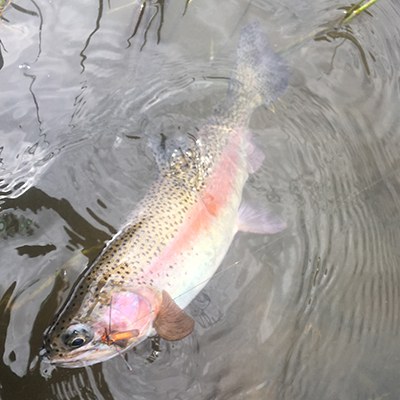While the Deschutes Land Trust often talks about creating habitat for steelhead and Chinook, there is another fish that also benefits from the habitat we help steward. This fish is the redband trout (Oncorhynchus mykiss ssp).
Native rainbow trout east of the Cascade mountains are often called redband trout. These fish are a primitive form of rainbow trout. In Central Oregon, we have the Interior Columbia Basin redband trout. You can find redband trout in the Metolius River, Whychus Creek, the Crooked River, and the Deschutes River. Generally, they are common in Central Oregon, although their abundance is limited in some areas.
Redband trout are non-anadromous, which means they do not migrate to the ocean. Instead, the typical life histories in our region are: 1. stream residents, 2. fluvial (migrating between larger and smaller streams), and 3. lake resident adfluvial (migrating between a lake and stream system). The stream resident and fluvial redband trout spend their whole life in flowing water, and may spawn in the headwaters of streams.
In our area, spawning can occur over many months, with March to May as the peak. Fry (recently hatched juveniles) usually emerge from the gravel in early summer. Depending on the steam and life history, redband trout may migrate to over-wintering locations in the fall. Redband trout mostly eat streamside and bottom dwelling macroinvertebrates, but larger adults (often in lakes) will eat other fish.
As with many native fish in our area, their population has dropped due to many factors, including loss of habitat and the introduction of non-native fish. Interior Columbia Basin redband trout are actually quite adaptable due to our region’s characteristics, like unpredictable and intermittent stream flows, high summer water temperatures, common droughts, and wildfires. Historically, redband trout populations have fluctuated based on these characteristics.
Redband trout prefer similar variable water habitats to other native fish. This includes riffles (a rocky or shallow part of a stream with rough water), pools, various sizes of gravel, large woody debris for cover, vegetation that overhangs the stream, and streamside vegetation.
As the Land Trust begins our stream restoration project of Whychus Creek at Rimrock Ranch, not only will steelhead and Chinook benefit from this work, but redband trout will as well. Returning the creek’s historical function is a win-win-win for the native fish of Whychus Creek. We look forward to seeing them flourish!
Sources:
US Fish and Wildlife Service, Great Basin Redband Trout
Western Native Trout Initiative, Redband Trout
Native Trout Fly Fishing, Columbia Basin Redband
Learn more:


